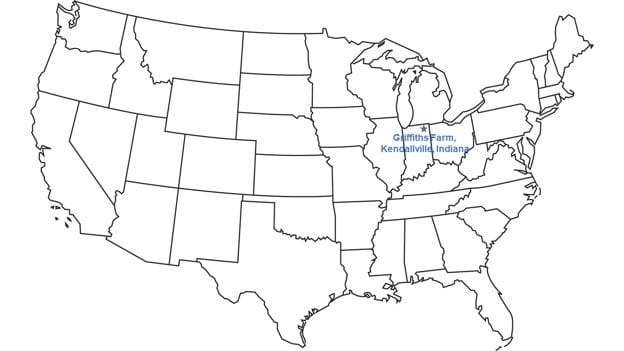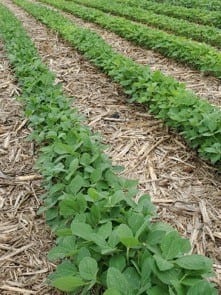
What a difference a few days can make!
At the end of May, after struggling through weeks of cool, wet weather, I wasn’t sure I would get all my fields planted. Prevented planting, or not planting some insured crops, had crossed my mind. But then the sun came out, temperatures warmed up, and a warm breeze helped dry out fields.
Between June 2 and June 8, I did more work than during the entire month of May. I finished planting soybeans and corn. Low spots in other fields that were drowned out got replanted. Early planted corn got side-dressed, or fertilized. And I mowed and baled my first cutting of hay. All followed by about 4 cm, or 1.5 inches, of rain.
Even the field that had been way too wet for me to terminate the cover crop worked out really well. A neighboring dairy farmer chopped the cover crop to make haylage, storing the forage at a high moisture content for feed. Then the breeze and warmer temperatures dried the field out in just a couple days. I did minimal tillage to work ruts from chopping the cover crop, and then got it planted.
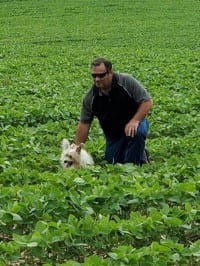 That was a lot of work in a short period of time. Thankfully, I own several tractors that sit idle most of the year. But in a year like this, when everything must be done quickly, the different tractors come in handy. Because I do all the field work myself, I can only drive one tractor at a time. But during this period of good weather, I had a different tractor hooked up to each piece of equipment, which helped me keep moving. I was able to jump into the next tractor and start working, rather than taking time to unhook a tractor from one machine and hook it up to another.
That was a lot of work in a short period of time. Thankfully, I own several tractors that sit idle most of the year. But in a year like this, when everything must be done quickly, the different tractors come in handy. Because I do all the field work myself, I can only drive one tractor at a time. But during this period of good weather, I had a different tractor hooked up to each piece of equipment, which helped me keep moving. I was able to jump into the next tractor and start working, rather than taking time to unhook a tractor from one machine and hook it up to another.
And we had phenomenal weather in my area of the U.S. Midwest throughout June, so my crops are looking really good. Temperatures have hovered between 24 and 29°C, or 75 and 85°F, and we’ve gotten amazingly well-timed rains.
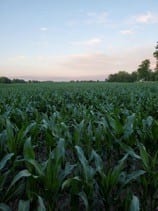
My soybeans all look really good. Seed emergence was excellent, and I’m very happy with how the crop is progressing. However, weed control has been an issue because of the cold, damp spring. As a farmer, I’m truly concerned about the potential to lose some of the options to control problem and resistant weeds.
Because of the cool weather and uneven soil temperatures, my corn did not germinate and emerge evenly. However, when I side-dressed it with nitrogen in a dry urea form with a stabilizer when the corn was 15 to 20 cm, or 6 to 8 inches, tall, it immediately rained about 3 cm, or 1.25 inches. Right away, that rain worked the fertilizer into the soil. Organic material on the top of the soil from past crops held that nitrogen there, so that none of those nutrients were lost. They were directly available to the corn, and you could see the difference in plant health the next day. And that perfectly-timed post-fertilization rain happened twice. I finished side-dressing the later-planted corn on June 20, followed by another nice rain that evening.
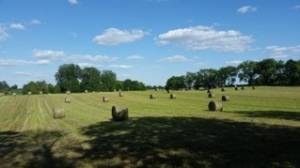 Making hay also went incredibly well. I started cutting hay about three weeks earlier than I did last year. After it was mowed, it dried in just two days – record time for this time of year. I can’t remember every getting a higher quality first cutting of hay because it was cut early and dried quickly. There was no moisture in the mowed plant stems, perhaps in part because of the late frost or cool weather earlier this spring. I baled the first cutting of hay into large round bales that will sell over the winter or next spring. I will get a second cutting of hay in a week or two, and I expect to get three or four cuttings total this season.
Making hay also went incredibly well. I started cutting hay about three weeks earlier than I did last year. After it was mowed, it dried in just two days – record time for this time of year. I can’t remember every getting a higher quality first cutting of hay because it was cut early and dried quickly. There was no moisture in the mowed plant stems, perhaps in part because of the late frost or cool weather earlier this spring. I baled the first cutting of hay into large round bales that will sell over the winter or next spring. I will get a second cutting of hay in a week or two, and I expect to get three or four cuttings total this season.
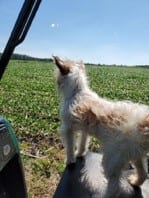
After getting all that field work done, I went to the sale barn and bought a few more beef cattle. They are grazing in my pasture and enjoying the beautiful weather, too. I guess I just don’t like free time.
My volunteer work with the United Soybean Board and the Indiana Soybean Alliance has required quite a few meetings over the past few months, as well. I was selected to serve as a work group lead for the soybean value creation framework target area meeting. I am now a Zoom meeting master. I can’t thank my fellow checkoff directors enough for evaluating, scoring and selecting projects to fund that will hopefully create soybean demand and make them more profitable in the future. Meeting digitally forced me to learn new technology, and that may help me better balance farming and serving the industry. I will be able to participate in meetings remotely when I can’t be away from the farm.
Finally, check out my help inspecting the soybean crop. I think she wants to be hired to participate in a crop tour this summer.
